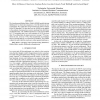Free Online Productivity Tools
i2Speak
i2Symbol
i2OCR
iTex2Img
iWeb2Print
iWeb2Shot
i2Type
iPdf2Split
iPdf2Merge
i2Bopomofo
i2Arabic
i2Style
i2Image
i2PDF
iLatex2Rtf
Sci2ools
120
Voted
ICIP
2007
IEEE
2007
IEEE
Robust Multi-Modal Group Action Recognition in Meetings from Disturbed Videos with the Asynchronous Hidden Markov Model
The Asynchronous Hidden Markov Model (AHMM) models the joint likelihood of two observation sequences, even if the streams are not synchronised. We explain this concept and how the model is trained by the EM algorithm. We then show how the AHMM can be applied to the analysis of group action events in meetings from both clear and disturbed data. The AHMM outperforms an early fusion HMM by 5.7% recognition rate (a rel. error reduction of 38.5%) for clear data. For occluded data, the improvement is in average 6.5% recognition rate (rel. error red. 40%). Thus asynchronity is a dominant factor in meeting analysis, even if the data is disturbed. The AHMM exploits this and is therefore much more robust against disturbances.
Asynchronous Hidden Markov | ICIP 2007 | Image Processing | Observation Sequences | Recognition Rate |
| Added | 08 Dec 2010 |
| Updated | 08 Dec 2010 |
| Type | Conference |
| Year | 2007 |
| Where | ICIP |
| Authors | Marc Al-Hames, Claus Lenz, Stephan Reiter, Joachim Schenk, Frank Wallhoff, Gerhard Rigoll |
Comments (0)

